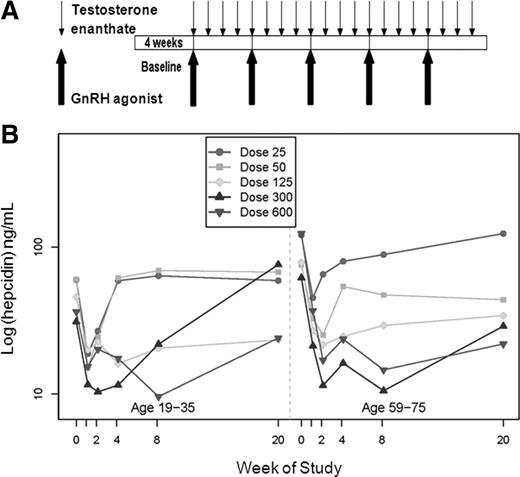madman
Super Moderator
Testosterone Administration During Energy Deficit Suppresses Hepcidin Concentrations and Increases Iron Utilization in Healthy Males (OR15-08-19)
Stephen Hennigar, Claire Berryman, Melissa Harris, James McClung, Jennifer Rood, and Stefan Pasiakos
Florida State University; Pennington Biomedical Research Center; and U.S. Army Research Institute of Environmental Medicine
Objectives: Military personnel are exposed to periods of energy deficit and stress, which is typically accompanied by reductions in testosterone concentrations and declines in iron status. Exogenous testosterone administration may increase erythropoiesis and iron availability.
The objective of this study was to determine the effects of exogenous testosterone on iron homeostasis in healthy young males during energy deficit.
Methods: Fifty males (24.8 ± 5.0 y, 78.6 ± 12.2 kg) completed this randomized, double-blind, placebo-controlled trial. Participants were provided a eucaloric diet during a 2-week free-living phase (day 1– 14). Following the free-living phase, participants completed a 4-week live-in phase (day 15–42). During the live-in phase participants were randomized to 200 mg testosterone enanthate/week (n = 24) or 1 mL sesame oil/week (placebo, n = 26) and were in an energy- and exercisei nduced energy deficit equal to 53 ± 4%. Blood was collected on days 14 and 42 to determine concentrations of testosterone, hemoglobin, hematocrit, ferritin, hepcidin, and erythroferrone. Data are reported as change scores (mean ± SD).
Results: Total testosterone concentrations increased with testosterone and declined with placebo (569 ± 271 nmol/L and −83 ± 142 nmol/L, P < 0.0001). Testosterone attenuated the decline in hemoglobin (−0.04 ± 0.7 g/L and −0.6 ± 0.8 g/dL, P < 0.01) and hematocrit (0.6 ± 2.2% and −1.3 ± 2.1%, P < 0.01) that occurred with placebo. Hepcidin (−3.7 ± 5.0 ng/mL and 2.1 ± 5.0 ng/mL, P < 0.001) and ferritin (−32.5 ± 38.6 ng/mL and 15.4 ± 41.2 ng/mL, P < 0.0001 ) were reduced with testosterone as compared to placebo. Erythroferrone (−0.5 ± 2.1 ng/mL and 0.5 ± 2.0 ng/mL, P = 0.11) did not differ when comparing testosterone to placebo.
Conclusions: Testosterone administration during energy deficit suppressed hepcidin concentrations and increased iron utilization in healthy young males. The reduction in hepcidin with testosterone administration appears to occur through an erythroferrone-independent mechanism.
Stephen Hennigar, Claire Berryman, Melissa Harris, James McClung, Jennifer Rood, and Stefan Pasiakos
Florida State University; Pennington Biomedical Research Center; and U.S. Army Research Institute of Environmental Medicine
Objectives: Military personnel are exposed to periods of energy deficit and stress, which is typically accompanied by reductions in testosterone concentrations and declines in iron status. Exogenous testosterone administration may increase erythropoiesis and iron availability.
The objective of this study was to determine the effects of exogenous testosterone on iron homeostasis in healthy young males during energy deficit.
Methods: Fifty males (24.8 ± 5.0 y, 78.6 ± 12.2 kg) completed this randomized, double-blind, placebo-controlled trial. Participants were provided a eucaloric diet during a 2-week free-living phase (day 1– 14). Following the free-living phase, participants completed a 4-week live-in phase (day 15–42). During the live-in phase participants were randomized to 200 mg testosterone enanthate/week (n = 24) or 1 mL sesame oil/week (placebo, n = 26) and were in an energy- and exercisei nduced energy deficit equal to 53 ± 4%. Blood was collected on days 14 and 42 to determine concentrations of testosterone, hemoglobin, hematocrit, ferritin, hepcidin, and erythroferrone. Data are reported as change scores (mean ± SD).
Results: Total testosterone concentrations increased with testosterone and declined with placebo (569 ± 271 nmol/L and −83 ± 142 nmol/L, P < 0.0001). Testosterone attenuated the decline in hemoglobin (−0.04 ± 0.7 g/L and −0.6 ± 0.8 g/dL, P < 0.01) and hematocrit (0.6 ± 2.2% and −1.3 ± 2.1%, P < 0.01) that occurred with placebo. Hepcidin (−3.7 ± 5.0 ng/mL and 2.1 ± 5.0 ng/mL, P < 0.001) and ferritin (−32.5 ± 38.6 ng/mL and 15.4 ± 41.2 ng/mL, P < 0.0001 ) were reduced with testosterone as compared to placebo. Erythroferrone (−0.5 ± 2.1 ng/mL and 0.5 ± 2.0 ng/mL, P = 0.11) did not differ when comparing testosterone to placebo.
Conclusions: Testosterone administration during energy deficit suppressed hepcidin concentrations and increased iron utilization in healthy young males. The reduction in hepcidin with testosterone administration appears to occur through an erythroferrone-independent mechanism.
Attachments
-
JUNE22-HEPCIDIN-10.1093@[email protected]84.3 KB · Views: 269












